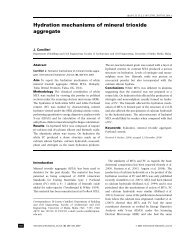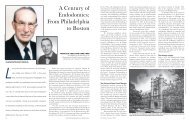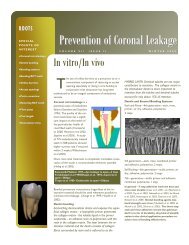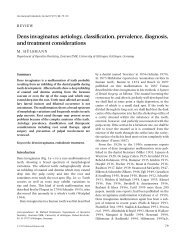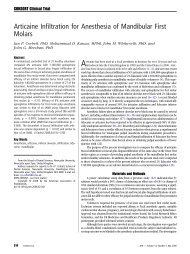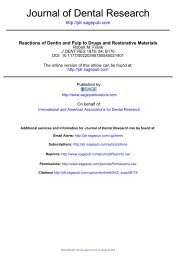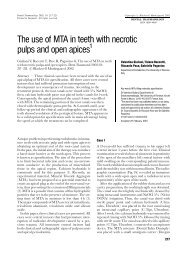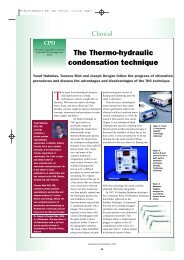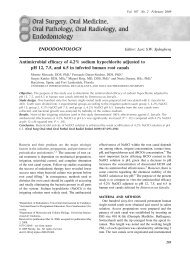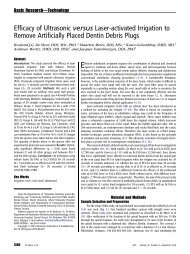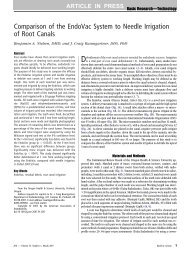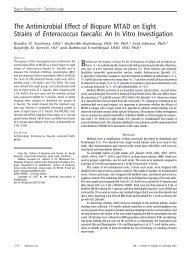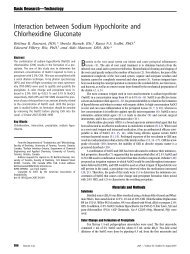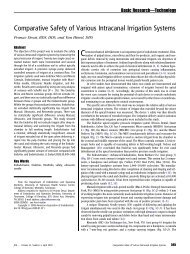Taurodontism - The EndoExperience
Taurodontism - The EndoExperience
Taurodontism - The EndoExperience
You also want an ePaper? Increase the reach of your titles
YUMPU automatically turns print PDFs into web optimized ePapers that Google loves.
REVIEW<br />
<strong>Taurodontism</strong>: a review of the condition and<br />
endodontic treatment challenges<br />
H. Jafarzadeh 1 , A. Azarpazhooh 2 & J. T. Mayhall 3<br />
1 Department of Endodontics, Faculty of Dentistry and Dental Research Center, Mashhad University of Medical Sciences, Mashhad,<br />
Iran; 2 Department of Endodontics and Community Dental Health Services Research Unit, Faculty of Dentistry, University of<br />
Toronto, Toronto, Ontario; and 3 Department of Community Dentistry, Faculty of Dentistry, University of Toronto, Toronto,<br />
Ontario, Canada<br />
Abstract<br />
Jafarzadeh H, Azarpazhooh A, Mayhall JT. <strong>Taurodontism</strong>:<br />
a review of the condition and endodontic treatment challenges.<br />
International Endodontic Journal, 41, 375–388, 2008.<br />
<strong>Taurodontism</strong> can be defined as a change in tooth<br />
shape caused by the failure of Hertwig’s epithelial<br />
sheath diaphragm to invaginate at the proper horizontal<br />
level. An enlarged pulp chamber, apical displacement<br />
of the pulpal floor, and no constriction at the level<br />
of the cementoenamel junction are the characteristic<br />
features. Although permanent molar teeth are most<br />
commonly affected, this change can also be seen in<br />
both the permanent and deciduous dentition, unilaterally<br />
or bilaterally, and in any combination of teeth or<br />
quadrants. Whilst it appears most frequently as an<br />
isolated anomaly, its association with several syndromes<br />
and abnormalities has also been reported. <strong>The</strong><br />
Introduction<br />
Dental morphological traits are of particular importance<br />
in the study of phylogenetic relationships and<br />
population affinities (Constant & Grine 2001). One of<br />
the most important abnormalities in tooth morphology<br />
is taurodontism. This abnormality is a developmental<br />
disturbance of a tooth that lacks constriction at the<br />
Correspondence: Dr Hamid Jafarzadeh, Faculty of Dentistry<br />
and Dental Research Center, Mashhad University of Medical<br />
Sciences, P.O. Box: 91735-984, Vakilabad Blvd, Mashhad,<br />
Iran (Tel.: +98-511-8829501; fax: +98-511-7626058;<br />
e-mail: hamid_j365@yahoo.com, JafarzadehBH@mums.ac.ir).<br />
doi:10.1111/j.1365-2591.2008.01388.x<br />
literature on taurodontism in the context of endodontics<br />
up to March 2007 was reviewed using PubMed,<br />
MEDLINE and Cumulative Index to Nursing & Allied<br />
Health Literature. Despite the clinical challenges in<br />
endodontic therapy, taurodontism has received little<br />
attention from clinicians. In performing root canal<br />
treatment on such teeth, one should appreciate the<br />
complexity of the root canal system, canal obliteration<br />
and configuration, and the potential for additional root<br />
canal systems. Careful exploration of the grooves<br />
between all orifices particularly with magnification,<br />
use of ultrasonic irrigation; and a modified filling<br />
technique are of particular use.<br />
Keywords: endodontic treatment, enlarged pulp<br />
chamber, syndrome, taurodontism.<br />
Received 12 July 2007; accepted 29 November 2007<br />
level of the cementoenamel junction (CEJ) and is<br />
characterized by vertically elongated pulp chambers,<br />
apical displacement of the pulpal floor, and bifurcation<br />
or trifurcation of the roots (Brkić & Filipović 1991,<br />
Hargreaves & Goodis 2002, Neville et al. 2002, Rao &<br />
Arathi 2006) (Fig. 1).<br />
<strong>The</strong> term taurodontism comes from the Latin term<br />
tauros, which means ‘bull’ and the Greek term odus,<br />
which means ‘tooth’ or ‘bull tooth’ (Keith 1913,<br />
Terezhalmy et al. 2001). It was first described by<br />
Gorjanović-Kramberger (1908); however, the term<br />
taurodontism was first introduced by Sir Arthur Keith<br />
(Keith 1913) to describe molar teeth resembling those<br />
of ungulates, particularly bulls.<br />
ª 2008 International Endodontic Journal International Endodontic Journal, 41, 375–388, 2008 375
376<br />
Endodontic challenge of taurodontism Jafarzadeh et al.<br />
Figure 1 A taurodont tooth with enlarged pulp chamber due<br />
to the apical displacement of the furcation area (Courtesy of<br />
Dr. Tim Wright, University of North Carolina and http://<br />
www.dent.unc.edu/research/defects/tds.cfm).<br />
<strong>The</strong> interest in these forms of molars first arose<br />
following the discovery of fossil remains of the Neanderthal<br />
race at Krapina in Croatia in 1899. <strong>Taurodontism</strong><br />
is prominent amongst the Krapina Neanderthal<br />
specimens and the earliest example of taurodontism is<br />
that of a Krapina 70 000-year-old anthropological<br />
specimen (Barker 1976). Keith (1913) suggested that<br />
taurodontism is a distinctive characteristic of the<br />
Neanderthals (Fig. 2). He pointed out molars of the<br />
modern dentitions, which he called ‘cynodont’ (doglike<br />
teeth which have relatively small pulp chambers, set<br />
low in the crown with a constriction in outline form of<br />
the chambers at about the CEJ) could not have been<br />
Figure 2 Maxillary molars of Pontnewydd 4 dated to Oxygen<br />
Isotope Stage 7 showing taurodontism characteristic of<br />
Neanderthals (Courtesy of the Natural History Museum,<br />
London).<br />
evolved from such taurodont teeth. <strong>The</strong> controversy<br />
engendered by this hypothesis over the years has been<br />
vigorous (Barker 1976).<br />
Because of the prevalence of taurodontism in modern<br />
dentitions (Shifman & Chanannel 1978, Ruprecht et al.<br />
1987, MacDonald-Jankowski & Li 1993, Schalk-van<br />
der Weide et al. 1993, Darwazeh et al. 1998) and the<br />
critical need for its true diagnosis and management,<br />
this review addresses the aetiology, anatomic and<br />
radiographic features of taurodontism, its association<br />
with various syndromes and anomalies, as well as<br />
important considerations in the endodontic treatment<br />
of such teeth.<br />
Search strategy<br />
A literature search for relevant articles regarding<br />
endodontic management in taurodontism was performed<br />
using Ovid MEDLINE(R) In-Process & Other<br />
Non-Indexed Citations, Ovid MEDLINE(R) Daily, Ovid<br />
MEDLINE(R), and Ovid OLDMEDLINE(R), CINAHL –<br />
Cumulative Index to Nursing & Allied Health Literature,<br />
Evidence Based Medicine of Cochrane Central<br />
Register of Controlled Trials, Cochrane Database of<br />
Systematic Reviews, Database of Abstracts of Reviews<br />
of Effects, EMBASE, Health and Psychosocial Instruments,<br />
HealthSTAR/Ovid Healthstar, International<br />
Pharmaceutical Abstracts, and PubMed. Table 1 shows<br />
the keywords and combinations of the keywords used.<br />
<strong>The</strong> search was limited to holdings at the University of<br />
Toronto in English. After removing duplicates, 15<br />
articles were retrieved and their reference lists were<br />
checked to identify any other articles relevant to the<br />
research question, which may have provided additional<br />
information. All of these were found in the original<br />
searches.<br />
Aetiology<br />
<strong>Taurodontism</strong> is caused by the failure of Hertwig’s<br />
epithelial sheath diaphragm to invaginate at the proper<br />
horizontal level (Hamner et al. 1964, Terezhalmy et al.<br />
2001). Interference in the epitheliomesenchymatose<br />
induction has also been proposed as a possible aetiology<br />
(Llamas & Jimenez-Planas 1993). Some reports suggest<br />
that taurodontism may be genetically transmitted<br />
(Fischer 1963, Witkop 1971, Goldstein & Gottlieb<br />
1973), and could be associated with an increased<br />
number of X chromosomes (Gage 1978). However,<br />
other researchers have found no simple genetic association<br />
but have noticed a trend for X chromosomal<br />
International Endodontic Journal, 41, 375–388, 2008 ª 2008 International Endodontic Journal
aneuploidy amongst patients with more severe forms of<br />
the trait (Jaspers & Witkop 1980).<br />
Autosomal transmission of the trait has also been<br />
observed (Mangion 1962). <strong>The</strong>se chromosomal abnormalities<br />
may disrupt the development of the tooth’s<br />
form; however, a specific genetic abnormality cannot<br />
be ascribed to taurodontism (Neville et al. 2002).<br />
Blumberg et al. (1971) biometrically studied the trait,<br />
ascribed taurodontism to a polygenic system, and<br />
described the anomaly as a continuous trait without<br />
discrete modes of expression.<br />
It is also proposed that taurodontism is a genetically<br />
determined trait and more advantageous than cynodontism<br />
in people with heavy masticatory habits [for<br />
example, the Neanderthals and Inuit (Eskimos), who<br />
prepared skins for protection from the cold by chewing]<br />
(Coon 1963) or in populations in which teeth were<br />
used as tools (Witkop 1976). Despite this theory, no<br />
evidence of taurodontism has been found in prehistoric<br />
American Indians, a group who must have also used<br />
their teeth extensively as tools (Sciulli 1977). Whilst<br />
genetic transmission can be demonstrated in most<br />
cases, other external factors can also damage developing<br />
dental structures in children and adolescents.<br />
Amongst these are infection (osteomyelitis) (Reichart<br />
& Quast 1975), disrupted developmental homeostasis<br />
(Witkop et al. 1988), high-dose chemotherapy (Greenberg<br />
& Glick 2003), and a history of bone marrow<br />
transplantation (Vaughan et al. 2005).<br />
Diagnosis<br />
<strong>The</strong> external features have been primarily used for the<br />
diagnosis of taurodontism. However, it should be<br />
noted that gross external characteristics are not<br />
sufficient to generate diagnosis (Mena 1971). In many<br />
cases, precise biometric methods are essential in<br />
diagnosis of taurodontism (Blumberg et al. 1971).<br />
Table 1 Search strategy<br />
Jafarzadeh et al. Endodontic challenge of taurodontism<br />
Tulensalo et al. (1989) examined a simple method of<br />
assessing taurodontism using orthopantomograms by<br />
measuring the distance between the baseline (connecting<br />
the mesial and distal points of the CEJ) and the<br />
highest point of the floor of the pulp chamber. <strong>The</strong>y<br />
concluded that this technique is reliable in epidemiologic<br />
investigations for assessing taurodontism in a<br />
developing dentition.<br />
Anatomic characteristics<br />
In taurodontism, the pulp chamber is extremely large<br />
and elongated with much greater apicoocclusal height<br />
than normal (Yeh & Hsu 1999, Sert & Bayrl 2004)<br />
and, thus, extends apically below the CEJ (Keith 1913,<br />
Terezhalmy et al. 2001). <strong>The</strong> CEJ constriction is less<br />
marked than that of the normal tooth, giving the<br />
taurodont a rectangular shape. Also, the furcation is<br />
displaced apically, resulting in shorter roots whilst<br />
enlarging the body of the tooth (Keith 1913, Durr et al.<br />
1980, Llamas & Jimenez-Planas 1993, Yeh & Hsu<br />
1999, Terezhalmy et al. 2001, Sert & Bayrl 2004).<br />
Clinical/radiographic characteristics<br />
Clinically, a taurodont appears as a normal tooth. In<br />
fact, because the body and roots of a taurodont tooth lie<br />
below the alveolar margin, its distinguishing features<br />
cannot be recognized clinically (Terezhalmy et al.<br />
2001, White & Pharoah 2004). <strong>The</strong>refore, the diagnosis<br />
of taurodontism is usually a subjective determination<br />
made from diagnostic radiographs (Durr et al.<br />
1980, Neville et al. 2002).<br />
<strong>The</strong> radiographic characteristics of taurodont tooth<br />
are: extension of the rectangular pulp chamber into the<br />
elongated body of the tooth, shortened roots and root<br />
canals, location of furcation (near the root apices),<br />
despite a normal crown size (Terezhalmy et al. 2001,<br />
# Search history Results<br />
1 (tauro or <strong>Taurodontism</strong> or taurodontic or taurodont$ or bull tooth or cynodont or hypotaurodont<br />
or mesotaurodont or hypertaurodont or hypo-T or meso-T or hyper-T).mp. [mp = ti, ot, ab, sh, de,<br />
hw, kw, tn, dm, mf, it, rw, nm, ac, tx, ct]<br />
995<br />
2 (Endodontic$ or root canal treatment or root canal therapy or pulp treatment or pulp therapy<br />
or pulpotomy or pulpectomy or pulp disease or pulp pathology$ or root canal).mp.<br />
[mp = ti, ot, ab, sh, de, hw, kw, tn, dm, mf, it, rw, nm, ac, tx, ct]<br />
40 962<br />
3 1 and 2 31<br />
4 Remove duplicates from 3 26<br />
5 Limit 4 to English 25<br />
6 Relevant articles remained after title/abstract screening 15<br />
ª 2008 International Endodontic Journal International Endodontic Journal, 41, 375–388, 2008 377
378<br />
Endodontic challenge of taurodontism Jafarzadeh et al.<br />
Table 2 Categorization indices for taurodontism<br />
Author(s)/year Criteria Categories Comments<br />
Shaw 1928 External morphological criteria<br />
(based on the relative amount<br />
of apical displacement of<br />
the pulp chamber floor)<br />
a) cynodont<br />
b) hypotaurodont<br />
c) mesotaurodont<br />
d) hypertaurodont<br />
Keene 1966 ‘Taurodont Index’<br />
(related the height of the pulp<br />
chamber to the length of<br />
the longest root)<br />
Blumberg<br />
et al. 1971<br />
Variable 1: mesiodistal diameter<br />
taken at contact points<br />
Variable 2: mesiodistal diameter<br />
taken at the level of the<br />
cementoenamel junction<br />
Variable 3: perpendicular<br />
distance from baseline to<br />
highest point on pulp chamber floor<br />
Variable 4: perpendicular<br />
distance from baseline to<br />
apex of longest root<br />
Variable 5: perpendicular<br />
distance from baseline to<br />
lowest point on pulp chamber<br />
roof<br />
Hypotaurodont: moderate<br />
enlargement of the pulp<br />
chamber at the expense of the<br />
roots<br />
Mesotaurodont: pulp is quite<br />
large and the roots short<br />
but still separate<br />
Hypertaurodont: prismatic or<br />
cylindrical forms where the<br />
pulp chamber nearly reaches<br />
the apex and then breaks up<br />
into 2 or 4 channels<br />
Single or pyramidal root<br />
(cuneiform): usually in the<br />
lower second molar where the<br />
pulp extends throughout the<br />
root without cervical<br />
constriction and exits via a<br />
single wide apical foramen<br />
Cynodont: index value of<br />
0–24.9%<br />
Hypo-T: index value of 25–49.9%<br />
Meso-T: index value of 50–74.9%<br />
Hyper-T: index value of 75–100%<br />
No categories provided as the<br />
authors believe that<br />
taurodontism is a continuous<br />
trait and therefore cannot<br />
be put into strict categories.<br />
First quantitative study of<br />
taurodontism<br />
Using second molar as a<br />
standard tooth for determining<br />
the degree of taurodontism<br />
Relative method<br />
Disadvantages:<br />
1) Use of landmarks in biologic<br />
structures which undergo<br />
changes<br />
2) Arbitrary selection and<br />
grading the index from 0 to 100<br />
into 4 groups appears to be<br />
unrealistic<br />
A biometric study<br />
A precise figure for each variable<br />
cannot be generally<br />
recommended because<br />
according to the race and type<br />
of molars, each variable may<br />
be different<br />
<strong>Taurodontism</strong> may be defined<br />
metrically<br />
International Endodontic Journal, 41, 375–388, 2008 ª 2008 International Endodontic Journal
Table 2 (continued)<br />
Author(s)/year Criteria Categories Comments<br />
Shifman &<br />
Chanannel<br />
1978<br />
Hargreaves & Goodis 2002, White & Pharoah 2004). It<br />
should be noted that taurodontism may be masked by<br />
wear-induced secondary dentine deposition so caution<br />
should be employed in interpreting an expression of<br />
taurodontism in heavily worn molars (Constant &<br />
Grine 2001).<br />
Categorization<br />
Differences of opinion exist as to how much displacement<br />
and/or morphologic change constitutes taurodontism.<br />
Most authors do not provide an objective<br />
analysis of cases presented, preferring a subjective<br />
diagnosis. Another problem complicating accurate<br />
assessment of the incidence of taurodontism is the<br />
inclusion of premolar teeth by some investigators<br />
(Madeira et al. 1986, Llamas & Jimenez-Planas 1993,<br />
Tiku et al. 2003), whereas others have questioned this<br />
inclusion (Ruprecht et al. 1987). In classifying taurodont<br />
teeth, it is necessary to consider not only the size<br />
of the pulp chamber and roots, but also the position of<br />
the body of the tooth in relation to the alveolar margin<br />
(Mena 1971). Different categorization indices have<br />
been proposed in the literature and are listed in<br />
Table 2.<br />
Epidemiology<br />
Point A: lowest point at the<br />
occlusal end of the pulp<br />
chamber<br />
Point B: highest point at<br />
the apical end of the chamber<br />
(distance from A to B)/(distance<br />
from A to the apex of the<br />
longest root) ‡0.2<br />
Distance from B to<br />
CEJ ‡ 2.5 mm<br />
<strong>Taurodontism</strong> was at first thought to be a primitive<br />
tooth form (Moorrees 1957). On the other hand, it is<br />
Jafarzadeh et al. Endodontic challenge of taurodontism<br />
Hypo-T:20–20.9%<br />
Meso-T:30–39.9%<br />
Hyper-T: 40–75%<br />
Advantage:<br />
overcome Keene’s index<br />
problem by using radiographs<br />
of teeth not exhibiting<br />
reparative dentin or<br />
roots which varied<br />
morphologically<br />
Disadvantage:<br />
range of measurement of<br />
‘the distance from B to the<br />
CEJ’ is small and thus<br />
subjected to error<br />
found in such diverse groups as Inuit, Aleuts, Mongolians,<br />
Europeans, Scandinavians, African Americans,<br />
Chinese and white Americans amongst others (Moorrees<br />
1957, Mjör 1972, Shifman & Buchner 1976,<br />
MacDonald-Jankowski & Li 1993, Goaz & White 1994,<br />
Darwazeh et al. 1998, Bäckman & Wahlin 2001, Tsesis<br />
et al. 2003). In the United States, most reports indicate<br />
a prevalence of 2.5–3.2% of the population (Neville<br />
et al. 2002).<br />
Table 3 summarizes the reported prevalence for<br />
taurodontism from different studies. <strong>The</strong> wide range<br />
of variability of prevalence [from less than 0.1%<br />
(Pindborg 1970) to 48% (Sarr et al. 2000)] is most<br />
likely because of different diagnostic criteria and racial<br />
variations. Some investigators believe the alteration is<br />
more of a variation of normal rather than a definitive<br />
pathologic anomaly (Neville et al. 2002).<br />
Except for a higher prevalence of taurodontism<br />
amongst females in a Chinese sample (MacDonald-<br />
Jankowski & Li 1993), no study has found a gender<br />
difference for this abnormality. Although permanent<br />
mandibular molars are most commonly affected<br />
(MacDonald-Jankowski & Li 1993, Rao & Arathi<br />
2006), taurodontism can be seen in both the permanent<br />
and deciduous dentition [very low incidence<br />
(MacDonald-Jankowski & Li 1993, Goaz & White<br />
1994, Darwazeh et al. 1998, Terezhalmy et al. 2001,<br />
Neville et al. 2002, Bhat et al. 2004, Rao & Arathi<br />
2006)], unilaterally or bilaterally, and in any combination<br />
of teeth or quadrants (White & Pharoah 2004).<br />
ª 2008 International Endodontic Journal International Endodontic Journal, 41, 375–388, 2008 379
380<br />
Endodontic challenge of taurodontism Jafarzadeh et al.<br />
Table 3 Prevalence of taurodontism<br />
Total<br />
prevalence (%) Method of study<br />
Sample<br />
size<br />
Least affected<br />
teeth Population/location<br />
Most affected<br />
teeth<br />
Author(s)/Year Tooth type<br />
Morphologic and<br />
biometric study<br />
Biometric study<br />
2.8 a (hypo-T)<br />
0.4 a (meso-T)<br />
247 a<br />
2.5 a<br />
11 905 a<br />
Other molars Americans of<br />
European heritage<br />
Mandibular<br />
Negroes and<br />
1st molar<br />
white American<br />
patients<br />
Periapical and<br />
bitewing<br />
radiographs<br />
Panoramic<br />
radiographs<br />
5.6 a<br />
1.5 b<br />
1200 a<br />
10 204 b<br />
Young adult<br />
Israeli patients<br />
Maxillary 2nd<br />
and 3rd<br />
molars (0.1%)<br />
4.37 a<br />
African<br />
1074<br />
American<br />
children<br />
a<br />
Mixed 4459 b<br />
Deciduous<br />
molars<br />
0.25 b<br />
Maxillary<br />
premolars (0%)<br />
Keene 1966 Molars Mandibular 2nd<br />
molars (100%)<br />
Blumberg et al.<br />
Mandibular Mandibular 2nd<br />
1971<br />
molars<br />
molars (in Negroes)<br />
Mandibular 3rd<br />
molars (in Whites)<br />
Shifman &<br />
Molars Mandibular 2nd<br />
Chanannel<br />
molars (66%)<br />
1978<br />
Jorgenson<br />
Deciduous and 1st permanent<br />
et al. 1982<br />
permanent molars<br />
molars<br />
Madeira<br />
Premolars Mandibular 1st<br />
et al. 1986<br />
premolars (0.42%)<br />
In vitro study<br />
(visual<br />
inspection and<br />
buccolingual<br />
radiographs)<br />
Complete mouth<br />
and panoramic<br />
radiographs<br />
In vitro study<br />
(anatomic and<br />
radiographic)<br />
11.3 a<br />
43.2 b<br />
1581 a<br />
1647 b<br />
Molars Not stated Not stated Saudi Arabian<br />
dental patients<br />
Ruprecht<br />
et al. 1987<br />
0.7 b<br />
379 b<br />
Other premolars Extracted<br />
premolars within<br />
a district area of<br />
Seville, Spain<br />
Premolars Maxillary<br />
premolars<br />
Llamas &<br />
Jimenez-Planas<br />
1993<br />
Panoramic<br />
radiographs<br />
28.9 a (with<br />
oligodontia)<br />
9.9 a (normal)<br />
117 a (with<br />
oligodontia)<br />
91 a (normal)<br />
_ _ Dutch patients<br />
with oligodontia<br />
Mandibular<br />
1st molars<br />
Schalk-van der<br />
Weide et al. 1993<br />
Panoramic<br />
radiographs<br />
Posterior periapical<br />
radiographs<br />
46.4 a<br />
21.7 b<br />
196 a<br />
1093 b<br />
8 a<br />
4.4 b<br />
875 a<br />
2636 b<br />
15–19 years old<br />
Chinese adults<br />
Jordanian adult<br />
dental patients<br />
Mandibular 1st<br />
molars<br />
Maxillary 2nd<br />
and mandibular<br />
1st premolars<br />
(0%)<br />
Mandibular 1st<br />
molars<br />
Maxillary 2nd<br />
molars<br />
Maxillary 2nd<br />
molars (31%)<br />
MacDonald-Jankowski 1st and 2nd<br />
& Li 1993<br />
molars<br />
Darwazeh et al. 1998 All posterior<br />
teeth<br />
Panoramic<br />
radiographs<br />
48 a<br />
18.8 b<br />
150 a<br />
1027 b<br />
150 consecutive<br />
15–19 years<br />
old black<br />
Senegalese adults<br />
International Endodontic Journal, 41, 375–388, 2008 ª 2008 International Endodontic Journal<br />
Maxillary 2nd<br />
molars<br />
Sarr et al. 2000 1st and 2nd<br />
molars
Bitewing and<br />
extraoral<br />
radiographs of<br />
the lateral side<br />
Lateral radiographs<br />
0.3 a<br />
739 a<br />
_ Caucasian 7-year-olds<br />
Umea, northern<br />
Sweden in 1976<br />
All teeth Maxillary and<br />
mandibular<br />
molars<br />
Bäckman &<br />
Wahlin 2001<br />
Varies based<br />
on the<br />
definition<br />
28 a from Khoisan<br />
and 68 a from<br />
Zulu<br />
Two recent<br />
population<br />
samples from<br />
southern Africa<br />
Mandibular<br />
1st molars<br />
Mandibular 3rd<br />
molars<br />
Mandibular<br />
molars<br />
Constant &<br />
Grine 2001<br />
Clinical and<br />
radiographic<br />
examination<br />
3.9 a<br />
1032 a<br />
Not stated Korean dental<br />
patients<br />
Park et al. 2006 All teeth Mandibular<br />
1st molars<br />
a<br />
Patient.<br />
b<br />
Teeth.<br />
Jafarzadeh et al. Endodontic challenge of taurodontism<br />
<strong>The</strong> degree of taurodontism increases from the first to<br />
the third molar (Mena 1971, Neville et al. 2002). Also,<br />
taurodontism is occasionally observed in mandibular<br />
premolars and even in maxillary premolars, mandibular<br />
canines, and incisors (Tennant 1966, Mena<br />
1971, Osborn 1981).<br />
Whilst taurodontism has been reported in premolar<br />
teeth (Tennant 1966, Mena 1971, Madeira et al. 1986,<br />
Llamas & Jimenez-Planas 1993, Tiku et al. 2003), the<br />
true diagnosis of taurodontism in premolars cannot be<br />
ascribed in situ as necessary radiographs depict the<br />
tooth only in a mesiodistal orientation (Neville et al.<br />
2002).<br />
Conditions associated with taurodontism<br />
<strong>Taurodontism</strong> appears most frequently as an isolated<br />
anomaly. However, its association with several syndromes<br />
and abnormalities has also been reported<br />
(Shifman & Buchner 1976, Genc et al. 1999, Yeh &<br />
Hsu 1999, Gedik & Cimen 2000). <strong>The</strong>se conditions are<br />
summarized in Tables 4 and 5. Many of these disorders<br />
have oral manifestations, which can be detected on<br />
dental radiographs as alterations in the morphology or<br />
chemical composition of the teeth; thus, dentists may<br />
be the first to detect them (Witkop 1976).<br />
Differential diagnosis<br />
In certain metabolic conditions including pseudo-hypoparthyroidism,<br />
hypophosphatasia, and hypophosphatemic<br />
vitamin D-resistant and dependent rickets, the<br />
pulp chamber may be enlarged but the teeth are of<br />
relatively normal form (Witkop 1976, Terezhalmy et al.<br />
2001, Chaussain-Miller et al. 2003). Another differential<br />
diagnosis is in the early stages of dentinogenesis<br />
imperfecta, where the appearance may resemble the<br />
large pulp chambers found in taurodontism (Hargreaves<br />
& Goodis 2002). Moreover, the developing molars may<br />
appear similar to taurodonts; however, an identification<br />
of wide apical foramina and incompletely formed roots<br />
helps in the differential diagnosis (White & Pharoah<br />
2004).<br />
Endodontic management<br />
A taurodont tooth shows wide variation in the size and<br />
shape of the pulp chamber, varying degrees of obliteration<br />
and canal configuration, apically positioned canal<br />
orifices, and the potential for additional root canal<br />
systems. <strong>The</strong>refore, root canal treatment becomes a<br />
ª 2008 International Endodontic Journal International Endodontic Journal, 41, 375–388, 2008 381
382<br />
Endodontic challenge of taurodontism Jafarzadeh et al.<br />
Table 4 Syndromes associated with taurodontism<br />
Prevalence of<br />
taurodontism<br />
Syndrome Author(s) Inheritance Oral findings Systemic findings<br />
55%<br />
36%<br />
66%<br />
56%<br />
75%<br />
Small nose<br />
Short stature<br />
Mental retardation<br />
Muscular hypotonia<br />
Macroglossia<br />
Delayed eruption<br />
Absence of tooth germs<br />
Additional 21<br />
chromosome<br />
Jaspers 1981,<br />
Bell et al. 1989,<br />
Alpöz & Eronat 1997,<br />
Rajić & Mestrović 1998<br />
Down syndrome<br />
(Trisomy 21)<br />
Cleft soft palate<br />
Small testes<br />
Missing premolars<br />
Azoospermia<br />
Delayed development<br />
Mental retardation<br />
of the permanent<br />
Chromosome<br />
tooth germs<br />
aberrations<br />
Severe bone loss<br />
Cataracts<br />
Jaws underdevelopment<br />
Mental retardation<br />
Gross periodontal disease<br />
Renal tubular<br />
Permanent teeth Impaction<br />
dysfunction<br />
Hypoplastic enamel Curly hair<br />
Dense bone<br />
Skull sclerosis<br />
Dentin dysplasia<br />
Scanty hair<br />
Hypoplastic-hypomaturated Scanty eyebrows<br />
enamel<br />
Thin dysplastic nails<br />
Agenesis<br />
Hoarse voice<br />
Wide mouth<br />
Cognitive profile<br />
Smaller size of teeth<br />
Mental retardation<br />
Aberrant shape of teeth<br />
Cardiovascular disease<br />
Additional X<br />
chromosome<br />
Klinefelter syndrome Mednick 1973,<br />
Hata et al. 2001,<br />
Pinkham et al. 2005,<br />
Schulman et al. 2005<br />
Not stated<br />
Tsai & O’Donnell 1997 X-linked<br />
recessive<br />
Lowe syndrome<br />
(Oculo-cerebro-renal<br />
syndrome)<br />
Not stated<br />
Autosomal<br />
dominant<br />
Spangler et al. 1998,<br />
Islam et al. 2005<br />
Tricho-dento-osseous<br />
syndrome (TDO)<br />
Not stated<br />
Autosomal<br />
dominant<br />
Koshiba et al. 1978,<br />
Neville et al. 2002<br />
Tricho-onycho-dental<br />
syndrome (TOD)<br />
1% for mandibular<br />
1st molars and<br />
41.7% for<br />
mandibular 2nd<br />
Williams syndrome Axelsson 2005 Gene deletion<br />
at chromosome 7<br />
molars<br />
Not stated<br />
Microcephaly<br />
Growth retardation<br />
Muscle hypotrophy<br />
Feeding difficulties<br />
Learning difficulties<br />
Microcephaly<br />
Small forehead<br />
Midfacial hypoplasia<br />
Posteriorly slanted ears<br />
Hoarse deep voice<br />
Cardiac and renal defects<br />
Polydactyly<br />
Brachydactyly<br />
Neuromuscular<br />
disturbance<br />
Microdontia<br />
Severe hypodontia<br />
Cleft lip and/or palate<br />
Taurodontic primary molars<br />
Delayed dental development<br />
Partial deletion of<br />
the terminal<br />
portion of the<br />
short arm of<br />
chromosome 4<br />
Breen 1998,<br />
Battaglia et al. 2001,<br />
Babich et al. 2004,<br />
Johnston & Franklin 2006<br />
Wolf-Hirschhorn<br />
syndrome<br />
Not stated<br />
Seckel syndrome Seymen et al. 2002 Autosomal recessive Microdontia<br />
Dentinal dysplasia<br />
Enamel hypoplasia<br />
87%<br />
Not stated<br />
Tomona et al. 2006 Gene deletion at<br />
Tooth agenesis<br />
chromosome 17<br />
Root dilaceration<br />
Gorlin 1970,<br />
Autosomal recessive Cleft palate<br />
Goldstein & Gottlieb 1973,<br />
Small tongue<br />
Goldstein & Medina 1974,<br />
Notching of the upper lip<br />
Young et al. 2001<br />
Smith-Magenis<br />
syndrome<br />
Mohr syndrome<br />
(Oral-facial-digital<br />
II syndrome)<br />
International Endodontic Journal, 41, 375–388, 2008 ª 2008 International Endodontic Journal
Not stated<br />
Obesity<br />
Hypotonia<br />
Oligophrenia<br />
Hypogonadism<br />
Small hands and feet<br />
Skeletal disorder<br />
Fibrous dysplasia<br />
Café-au-lait pigmentation<br />
Dwarfism<br />
Polydactyly<br />
Syndactyly<br />
Enamel-dentine<br />
dysplasia<br />
Bassarelli et al. 1991 Gene deletion at<br />
chromosome 15<br />
Prader-Labhart-Willi<br />
syndrome<br />
9%<br />
Oligodontia<br />
Malocclusion<br />
Tooth rotation<br />
Malocclusion<br />
Reduced crown size<br />
Supernumerary tooth<br />
Early eruption of teeth<br />
Shovel-shaped incisors<br />
Anterior open bite<br />
Dental malocclusion<br />
Delayed tooth eruption<br />
Crowding of the dental<br />
arch<br />
Hypodontia<br />
Micrognathia<br />
Conic-shaped incisors<br />
Agenesis of permanent<br />
teeth<br />
Hypodontia<br />
Wide spacing<br />
Delayed tooth eruption<br />
Screwdriver-shaped<br />
incisors<br />
Akintoye et al. 2003 Autosomal<br />
dominant<br />
McCune-Albright<br />
syndrome<br />
Not stated<br />
Autosomal<br />
recessive<br />
Hattab et al. 1998,<br />
Hunter & Roberts 1998<br />
Ellis van Creveld<br />
syndrome<br />
Not stated<br />
Syndactyly<br />
Proptosis of eyes<br />
Mental retardation<br />
Skeletal deformities<br />
Autosomal<br />
dominant<br />
Apert syndrome Terezhalmy et al. 2001,<br />
Tosun & Sener 2006<br />
Not stated<br />
Microcephaly<br />
Microphthalmia<br />
Urogenital anomalies<br />
Developmental<br />
retardation<br />
Short stature<br />
Mental retardation<br />
Skeletal abnormalities<br />
Long palpebral fissures<br />
Ersin et al. 2003 X-linked<br />
recessive<br />
Lenz microphthalmia<br />
syndrome<br />
Not stated<br />
Kabuki syndrome Petzold et al. 2003 Autosomal<br />
dominant<br />
Jafarzadeh et al. Endodontic challenge of taurodontism<br />
ª 2008 International Endodontic Journal International Endodontic Journal, 41, 375–388, 2008 383
384<br />
Endodontic challenge of taurodontism Jafarzadeh et al.<br />
Table 5 Other conditions associated with taurodontism<br />
Abnormal condition Author(s) Prevalence of taurodontism<br />
47,XXY karyotype<br />
(Additional X chromosome)<br />
47,XXX karyotype<br />
(Additional X chromosome)<br />
AIHHT<br />
Amelogenesis imperfecta<br />
(hypoplastic-hypomaturation<br />
with taurodontism)<br />
challenge (Hargreaves & Goodis 2002, Tsesis et al.<br />
2003, Rao & Arathi 2006). Moreover, whilst the<br />
radiographic feature of a taurodont tooth is characteristic,<br />
pre-treatment radiographs produce little information<br />
about the root canal system (Yeh & Hsu 1999).<br />
Finally, the results of pulp testing contribute little<br />
information about the effect of a large pulp chamber on<br />
tooth sensitivity (Durr et al. 1980).<br />
<strong>The</strong>re are different views regarding access cavity<br />
design and preparation: Shifman & Buchner (1976)<br />
argued that access to the root canal orifices can easily<br />
obtained as the floor of the pulp chamber cannot affected<br />
by the formation of reactional dentine as in normal<br />
teeth. In contrast, Durr et al. (1980) suggested that<br />
morphology could hamper the location of the orifices,<br />
thus creating difficulty in instrumentation and filling.<br />
Varrela & Alvesalo 1988,<br />
30%<br />
Gardner & Girgis 1978<br />
Varrela & Alvesalo 1989 Direct relation with the number of X<br />
chromosomes<br />
Gage 1978,<br />
Seow 1993,<br />
Winter 1996,<br />
Collins et al. 1999,<br />
Price et al. 1999,<br />
Aldred et al. 2002,<br />
Dong et al. 2005<br />
Oligodontia Terezhalmy et al. 2001,<br />
Schalk-van der Weide et al. 1993,<br />
Lai & Seow 1989<br />
<strong>The</strong> relationship between AIHHT and<br />
taurodontism is controversial<br />
(Winter 1996, Collins et al. 1999)<br />
29% (Schalk-van der Weide et al. 1993)<br />
34% (Lai & Seow 1989)<br />
Supernumerary teeth Genc et al. 1999 Not stated<br />
Triad of microdontia-taurodontia-dens Casamassimo et al. 1978,<br />
Not stated<br />
invagination<br />
Galindo-Moreno et al. 2003<br />
Pulpal calcification Darwazeh et al. 1998,<br />
26% of taurodontic cases have pulpal<br />
Miller 1969<br />
calcification<br />
Cleft lip or palate Neville et al. 2002,<br />
Laatikainen & Ranta 1996<br />
41%<br />
Ectodermal dysplasia<br />
Neville et al. 2002,<br />
Not stated<br />
(e.g. Otodental dysplasia,<br />
Jaspers & Witkop 1980,<br />
Cranioectodermal dysplasia, and<br />
Glavina et al. 2001,<br />
Rapp-Hodgkin syndrome)<br />
Levin et al. 1975,<br />
Chen et al. 1988,<br />
Zannolli et al. 2001<br />
Osteoporosis Fuks et al. 1982 Not stated<br />
Thalassaemia major Hazza’a & Al-Jamal 2006 34%<br />
Dwarfism Neville et al. 2002,<br />
Terezhalmy et al. 2001,<br />
Gardner & Girgis 1977,<br />
Sauk & Delaney 1973,<br />
Stewart et al. 1971<br />
Not stated<br />
Dyskeratosis congenita Terezhalmy et al. 2001 Not stated<br />
Epidermolysis bullosa Terezhalmy et al. 2001 Not stated<br />
Each taurodont tooth may have extraordinary root<br />
canals in terms of shape and number. A complicated<br />
root canal treatment has been reported for a mandibular<br />
taurodont tooth with five canals, only three of<br />
which could be instrumented to the apex (Hayashi<br />
1994). <strong>The</strong>refore, careful exploration of the grooves<br />
between all orifices, especially with magnification<br />
(Tsesis et al. 2003), has been recommended to reveal<br />
additional orifices and canals (Yeh & Hsu 1999).<br />
Because the pulp of a taurodont is usually voluminous,<br />
in order to ensure complete removal of the<br />
necrotic pulp, 2.5% sodium hypochlorite has been<br />
suggested initially as an irrigant to digest pulp tissue<br />
(Prakash et al. 2005). Moreover, as adequate instrumentation<br />
of the irregular root canal system cannot be<br />
anticipated, Widerman & Serene (1971) suggested that<br />
International Endodontic Journal, 41, 375–388, 2008 ª 2008 International Endodontic Journal
additional efforts should be made by irrigating the<br />
canals with 2.5% sodium hypochlorite in order to<br />
dissolve as much necrotic material as possible. Application<br />
of final ultrasonic irrigation may ensure that no<br />
pulp tissue remains (Prakash et al. 2005).<br />
Because of the complexity of the root canal anatomy<br />
and the proximity of the buccal orifices, complete<br />
filling of the root canal system in taurodontism is<br />
challenging. A modified filling technique has been<br />
proposed, which consists of combined lateral compaction<br />
in the apical region with vertical compaction of<br />
the elongated pulp chamber, using the system B<br />
device (EIE/Analytic Technology, San Diego, CA, USA)<br />
(Tsesis et al. 2003).<br />
Another endodontic challenge related to taurodonts<br />
is intentional replantation. <strong>The</strong> extraction of a taurodont<br />
tooth is usually complicated because of a dilated<br />
apical third (Yeh & Hsu 1999). In contrast, it has also<br />
been hypothesized that because of its large body, little<br />
surface area of a taurodont tooth is embedded in the<br />
alveolus. This feature would make extraction less<br />
difficult as long as the roots are not widely divergent<br />
(Durr et al. 1980). Finally, it should be noted that in<br />
cases of hypertaurodont (where the pulp chamber<br />
nearly reaches the apex and then breaks up into two or<br />
four channels) vital pulpotomy instead of routine<br />
pulpectomy may be considered as the treatment of<br />
choice (Shifman & Buchner 1976, Neville et al. 2002).<br />
For the prosthetic treatment of a taurodont tooth, it<br />
has been recommended that post-placement be avoided<br />
for tooth reconstruction (Tsesis et al. 2003). Because<br />
less surface area of the tooth is embedded in the<br />
alveolus, a taurodont tooth may not have as much<br />
stability as a cynodont when used as an abutment for<br />
either prosthetic or orthodontic purposes (Durr et al.<br />
1980).<br />
From a periodontal standpoint, taurodont teeth may,<br />
in specific cases, offer favourable prognosis. Where<br />
periodontal pocketing or gingival recession occurs, the<br />
chances of furcation involvement are considerably less<br />
than those in normal teeth because taurodont teeth<br />
have to demonstrate significant periodontal destruction<br />
before furcation involvement occurs (Shifman & Buchner<br />
1976, Neville et al. 2002).<br />
Conclusion<br />
This review attempts to address the aetiology, anatomic<br />
and radiographic features of taurodontism, its association<br />
with some syndromes and anomalies, as well as<br />
important considerations in the endodontic treatment<br />
of such teeth. Taurodont teeth show wide variations in<br />
the size and shape of pulp chambers, varying degrees of<br />
obliteration and canal complexity, low canal orifices,<br />
and the potential for additional root canal systems. On<br />
the basis of the evidence presented here, it can be seen<br />
that taurodontism has hitherto received insufficient<br />
attention from clinicians. In performing root canal<br />
treatment on these teeth, one should appreciate the<br />
complexity of the root canal system. Careful exploration<br />
of the grooves between all orifices, particularly<br />
with magnification; ultrasonic irrigation; and a modified<br />
filling technique are recommended. No long-term<br />
follow-up studies have been published regarding endodontically<br />
treated taurodont teeth.<br />
Acknowledgement<br />
<strong>The</strong> authors would like to thank Professor Larz S.W.<br />
Spa˚ngberg (School of Dental Medicine, University of<br />
Connecticut Health Center, Farmington, Connecticut,<br />
USA) for his critical review and beneficial comments.<br />
References<br />
Jafarzadeh et al. Endodontic challenge of taurodontism<br />
Akintoye SO, Lee JS, Feimster T et al. (2003) Dental characteristics<br />
of fibrous dysplasia and McCune-Albright syndrome.<br />
Oral Surgery, Oral Medicine, Oral Pathology, Oral<br />
Radiology and Endodontology 96, 275–82.<br />
Aldred MJ, Savarirayan R, Lamandé SR, Crawford PJ (2002)<br />
Clinical and radiographic features of a family with autosomal<br />
dominant amelogenesis imperfecta with taurodontism.<br />
Oral Disease 8, 62–8.<br />
Alpöz AR, Eronat C (1997) <strong>Taurodontism</strong> in children associated<br />
with trisomy 21 syndrome. <strong>The</strong> Journal of Clinical<br />
Pediatric Dentistry 22, 37–9.<br />
Axelsson S (2005) Variability of the cranial and dental<br />
phenotype in Williams syndrome. Swedish Dental Journal<br />
170, 3–67.<br />
Babich SB, Banducci C, Teplitsky P (2004) Dental characteristics<br />
of the Wolf-Hirschhorn syndrome: a case report.<br />
Special Care in Dentistry 24, 229–31.<br />
Bäckman B, Wahlin YB (2001) Variations in number and<br />
morphology of permanent teeth in 7-year-old Swedish<br />
children. International Journal of Paediatric Dentistry 11,<br />
11–7.<br />
Barker BC (1976) <strong>Taurodontism</strong>: the incidence and possible<br />
significance of the trait. Australian Dental Journal 21, 272–6.<br />
Bassarelli V, Baccetti T, Bassarelli T, Franchi L (1991) <strong>The</strong><br />
dentomaxillofacial characteristics of the Prader-Labhart-<br />
Willi syndrome. A clinical case report. Minerva Stomatologica<br />
40, 811–9.<br />
Battaglia A, Carey JC, Wright TJ (2001) Wolf-Hirschhorn (4p-)<br />
syndrome. Advances in Pediatrics 48, 75–113.<br />
ª 2008 International Endodontic Journal International Endodontic Journal, 41, 375–388, 2008 385
386<br />
Endodontic challenge of taurodontism Jafarzadeh et al.<br />
Bell J, Civil CR, Townsend GC, Brown RH (1989) <strong>The</strong><br />
prevalence of taurodontism in Down’s syndrome. Journal of<br />
Mental Deficiency Research 33, 467–76.<br />
Bhat SS, Sargod S, Mohammed SV (2004) <strong>Taurodontism</strong> in<br />
deciduous Molars–a Case Report. Journal of the Indian Society<br />
of Pedodontics and Preventive Dentistry 22, 193–6.<br />
Blumberg JE, Hylander WL, Goepp RA (1971) <strong>Taurodontism</strong>:<br />
a biometric study. American Journal of Physical Anthropology<br />
34, 243–55.<br />
Breen GH (1998) <strong>Taurodontism</strong>, an unreported dental finding<br />
in Wolf-Hirschhorn (4p-) syndrome. ASDC Journal of<br />
Dentistry for Children 65, 344–5.<br />
Brkić H, Filipović I (1991) <strong>The</strong> meaning of taurodontism in oral<br />
surgery–case report. Acta Stomatologica Croatica 25, 123–7.<br />
Casamassimo PS, Nowak AJ, Ettinger RL, Schlenker DJ (1978)<br />
An unusual triad: microdontia, taurodontia, and dens<br />
invaginatus. Oral Surgery, Oral Medicine and Oral Pathology<br />
45, 107–12.<br />
Chaussain-Miller C, Sinding C, Wolikow M, Lasfargues JJ,<br />
Godeau G, Garabédian M (2003) Dental abnormalities in<br />
patients with familial hypophosphatemic vitamin D-resistant<br />
rickets: prevention by early treatment with 1-hydroxyvitamin<br />
D. <strong>The</strong> Journal of Pediatrics 142, 324–31.<br />
Chen RJ, Chen HS, Lin LM, Lin CC, Jorgenson RJ (1988)<br />
‘‘Otodental’’ dysplasia. Oral Surgery, Oral Medicine and Oral<br />
Pathology 66, 353–8.<br />
Collins MA, Mauriello SM, Tyndall DA, Wright JT (1999)<br />
Dental anomalies associated with amelogenesis imperfecta:<br />
a radiographic assessment. Oral Surgery, Oral Medicine, Oral<br />
Pathology, Oral Radiology and Endodontology 88, 358–64.<br />
Constant DA, Grine FE (2001) A review of taurodontism with<br />
new data on indigenous southern African populations.<br />
Archives of Oral Biology 46, 1021–9.<br />
Coon CS (1963) Origin of races. Science 140, 208.<br />
Darwazeh AM, Hamasha AA, Pillai K (1998) Prevalence of<br />
taurodontism in Jordanian dental patients. Dentomaxillofacial<br />
Radiology 27, 163–5.<br />
Dong J, Amor D, Aldred MJ, Gu T, Escamilla M, MacDougall M<br />
(2005) DLX3 mutation associated with autosomal dominant<br />
amelogenesis imperfecta with taurodontism. American<br />
Journal of Medical Genetics Part A 133, 138–41.<br />
Durr DP, Campos CA, Ayers CS (1980) Clinical significance of<br />
taurodontism. Journal of the American Dental Association<br />
100, 378–81.<br />
Ersin NK, Tugsel Z, Gökce B, Ozpinar B, Eronat N (2003) Lenz<br />
microphthalmia syndrome with dental anomalies: a case<br />
report. Journal of Dentistry for Children 70, 262–5.<br />
Fischer H (1963) Recent examples of anomalous molars of the<br />
Krapina type. International Dental Journal 13, 506–9.<br />
Fuks AB, Levin S, Grinbaum M, Chosack A (1982) Multiple<br />
taurodontism associated with osteoporosis. <strong>The</strong> Journal of<br />
Pedodontics 7, 68–74.<br />
Gage JP (1978) <strong>Taurodontism</strong> and enamel hypomaturation<br />
associated with X-linked abnormalities. Clinical Genetics 14,<br />
159–64.<br />
Galindo-Moreno PA, Parra-Vázquez MJ, Sánchez-Fernández E,<br />
Avila-Ortiz GA (2003) Maxillary cyst associated with an<br />
invaginated tooth: a case report and literature review.<br />
Quintessence International 34, 509–14.<br />
Gardner DG, Girgis SS (1977) <strong>Taurodontism</strong>, short roots, and<br />
external resorption, associated with short stature and a<br />
small head. Oral Surgery, Oral Medicine and Oral Pathology<br />
44, 271–3.<br />
Gardner DG, Girgis SS (1978) <strong>Taurodontism</strong>, shovel-shaped<br />
incisors and the Klinefelter syndrome. Dental Journal 44,<br />
372–3.<br />
Gedik R, Cimen M (2000) Multiple taurodontism: report of<br />
case. ASDC Journal of Dentistry for Children 67, 216–7.<br />
Genc A, Namdar F, Goker K, Atasu M (1999) <strong>Taurodontism</strong> in<br />
association with supernumerary teeth. <strong>The</strong> Journal of Clinical<br />
Pediatric Dentistry 23, 151–4.<br />
Glavina D, Majstorović M, Lulić-Dukić O, Jurić H (2001)<br />
Hypohidrotic ectodermal dysplasia: dental features and<br />
carriers detection. Collegium Antropologicum 25, 303–10.<br />
Goaz PW, White SC (1994) Oral Radiology (Principles and<br />
Interpretation), 3rd edn. Louis, USA: Mosby.<br />
Goldstein E, Gottlieb MA (1973) <strong>Taurodontism</strong>: familial<br />
tendencies demonstrated in eleven of fourteen case<br />
reports. Oral Surgery, Oral Medicine and Oral Pathology<br />
36, 131–44.<br />
Goldstein E, Medina JL (1974) Mohr syndrome or oral-facialdigital<br />
II: report of two cases. Journal of the American Dental<br />
Association 89, 377–82.<br />
Gorjanović-Kramberger K (1908) Über prismatische molarwurzein<br />
rezenter und diluvialer menschen. Anatomischer<br />
Anzeiger 32, 401–13.<br />
Gorlin RJ (1970) Thoma’s Oral Pathology, 6th edn. St. Louis:<br />
Mosby.<br />
Greenberg MS, Glick M (2003) Burket’s Oral Medicine-Diagnosis<br />
and Treatment, 10th edn. Hamilton, ON, Canada: BC Decker.<br />
Hamner JE III, Witkop CJ Jr, Metro PS(1964) <strong>Taurodontism</strong>.<br />
Report of a case, Oral Surgery Oral Medicine and Oral<br />
Pathology 18, 409–18.<br />
Hargreaves KM, Goodis HE (2002) Seltzer and Bender’s Dental<br />
Pulp, 3rd edn. Chicago: Quintessence Pub Co.<br />
Hata S, Maruyama Y, Fujita Y, Mayanagi H (2001) <strong>The</strong><br />
dentofacial manifestations of XXXXY syndrome: a case<br />
report. International Journal of Paediatric Dentistry 11,<br />
138–42.<br />
Hattab FN, Yassin OM, Sasa IS (1998) Oral manifestations of<br />
Ellis-van Creveld syndrome: report of two siblings with<br />
unusual dental anomalies. <strong>The</strong> Journal of Clinical Pediatric<br />
Dentistry 22, 159–65.<br />
Hayashi Y (1994) Endodontic treatment in taurodontism.<br />
Journal of Endodontics 20, 357–8.<br />
Hazza’a AM, Al-Jamal G (2006) Radiographic features of the<br />
jaws and teeth in thalassaemia major. Dentomaxillofacial<br />
Radiology 35, 283–8.<br />
Hunter ML, Roberts GJ (1998) Oral and dental anomalies in<br />
Ellis van Creveld syndrome (chondroectodermal dysplasia):<br />
International Endodontic Journal, 41, 375–388, 2008 ª 2008 International Endodontic Journal
eport of a case. International Journal of Paediatric Dentistry 8,<br />
153–7.<br />
Islam M, Lurie AG, Reichenberger E (2005) Clinical features of<br />
tricho-dento-osseous syndrome and presentation of three<br />
new cases: an addition to clinical heterogeneity. Oral<br />
Surgery, Oral Medicine, Oral Pathology, Oral Radiology and<br />
Endodontology 100, 736–42.<br />
Jaspers MT (1981) <strong>Taurodontism</strong> in the Down syndrome. Oral<br />
Surgery, Oral Medicine and Oral Pathology 51, 632–6.<br />
Jaspers MT, Witkop CJ Jr (1980) <strong>Taurodontism</strong>, an isolated<br />
trait associated with syndromes and X-chromosomal<br />
aneuploidy. American Journal of Human Genetics 32, 396–<br />
413.<br />
Johnston NJ, Franklin DL (2006) Dental findings of a child<br />
with Wolf-Hirschhorn syndrome. International Journal of<br />
Paediatric Dentistry 16, 139–42.<br />
Jorgenson RJ, Salinas CF, Shapiro SD (1982) <strong>The</strong> prevalence of<br />
taurodontism in a select population. Journal of Craniofacial<br />
Genetics and Developmental Biology 2, 125–35.<br />
Keene HJ (1966) A morphologic and biometric study of<br />
taurodontism in a contemporary population. American<br />
Journal of Physical Anthropology 25, 208–9.<br />
Keith A (1913) Problems relating to the teeth of the earlier<br />
forms of prehistoric man. Journal of the Royal Society of<br />
Medicine 6, 103–24.<br />
Koshiba H, Kimura O, Nakata M, Witkop CJ Jr (1978) Clinical,<br />
genetic, and histologic features of the trichoonychodental<br />
(TOD) syndrome. Oral Surgery, Oral Medicine and Oral<br />
Pathology 46, 376–85.<br />
Laatikainen T, Ranta R (1996) <strong>Taurodontism</strong> in twins with<br />
cleft lip and/or palate. European Journal of Oral Science 104,<br />
82–6.<br />
Lai PY, Seow WK (1989) A controlled study of the association<br />
of various dental anomalies with hypodontia of permanent<br />
teeth. Pediatric Dentistry 11, 291–6.<br />
Levin LS, Jorgenson RJ, Cook RA (1975) Otodental dysplasia: a<br />
‘‘new’’ ectodermal dysplasia. Clinical Genetics 8, 136–44.<br />
Llamas R, Jimenez-Planas A (1993) <strong>Taurodontism</strong> in premolars.<br />
Oral Surgery, Oral Medicine and Oral Pathology 75,<br />
501–5.<br />
MacDonald-Jankowski DS, Li TT (1993) <strong>Taurodontism</strong> in a<br />
young adult Chinese population. Dentomaxillofacial Radiology<br />
22, 140–4.<br />
Madeira MC, Leite HF, Niccoli Filho WD, Simões S (1986)<br />
Prevalence of taurodontism in premolars. Oral Surgery, Oral<br />
Medicine and Oral Pathology 61, 158–62.<br />
Mangion JJ (1962) Two cases of taurodontism in modern<br />
human jaws. British Dental Journal 113, 309–12.<br />
Mednick GA (1973) Two case reports: taurodontism and<br />
taurodontism in Kleinfelter’s syndrome. Journal of the<br />
Michigan Dental Association 55, 212–5.<br />
Mena CA (1971) <strong>Taurodontism</strong>. Oral Surgery, Oral Medicine<br />
and Oral Pathology 32, 812–23.<br />
Miller WA (1969) Pulp calcifications in a taurodont tooth.<br />
British Dental Journal 126, 456–9.<br />
Jafarzadeh et al. Endodontic challenge of taurodontism<br />
Mjör IA (1972) <strong>The</strong> structure of taurodont teeth. ASDC Journal<br />
of Dentistry for Children 39, 459–63.<br />
Moorrees CFA (1957) <strong>The</strong> Aleut Dentition: A Correlative Study of<br />
Dental Characteristics of an Eskimoid People, 1st edn. Cambridge:<br />
Harvard University Press.<br />
Neville BW, Damm DD, Allen CM, Bouquot JE (2002) Oral &<br />
Maxillofacial Pathology, 5th edn. Philadelphia: W.B. Saunders.<br />
Osborn JW (1981) Dental Anatomy and Embryology. Oxford:<br />
Blackwell scientific publications.<br />
Park GJ, Kim SK, Kim S, Lee CH (2006) Prevalence and<br />
pattern of dental developmental anomalies in Korean<br />
children. Journal of Oral Pathology and Medicine 35, 453<br />
(abstract).<br />
Petzold D, Kratzsch E, Opitz CH, Tinschert S (2003) <strong>The</strong><br />
Kabuki syndrome: four patients with oral abnormalities.<br />
European Journal of Orthodontics 25, 13–9.<br />
Pindborg JJ (1970) Pathology of the Dental Hard Tissues.<br />
Copenhagen: Munksgaard.<br />
Pinkham JR, Casamassimo PS, McTigue DJ, Fields HW,<br />
Nowak AJ (2005) Pediatric Dentistry. Infancy through<br />
Adolescence, 4th edn. Philadelphia, USA: WB Saunders.<br />
Prakash R, Vishnu C, Suma B, Velmurugan N, Kandaswamy D<br />
(2005) Endodontic management of taurodontic teeth. Indian<br />
Journal of Dental Research 16, 177–81.<br />
Price JA, Wright JT, Walker SJ, Crawford PJ, Aldred MJ, Hart<br />
TC (1999) Tricho-dento-osseous syndrome and amelogenesis<br />
imperfecta with taurodontism are genetically distinct<br />
conditions. Clinical Genetics 56, 35–40.<br />
Rajić Z, Mestrović SR (1998) <strong>Taurodontism</strong> in Down’s<br />
syndrome. Collegium Antropologicum 22, 63–7.<br />
Rao A, Arathi R (2006) <strong>Taurodontism</strong> of deciduous and<br />
permanent molars: report of two cases. Journal of the<br />
Indian Society of Pedodontics and Preventive Dentistry 24,<br />
42–4.<br />
Reichart P, Quast U (1975) Mandibular infection as a possible<br />
aetiological factor in taurodontism. Journal of Dentistry 3,<br />
198–202.<br />
Ruprecht A, Batniji S, el-Neweihi E (1987) <strong>The</strong> incidence of<br />
taurodontism in dental patients. Oral Surgery, Oral Medicine<br />
and Oral Pathology 63, 743–7.<br />
Sarr M, Toure B, Kane AW, Fall F, Wone MM (2000)<br />
<strong>Taurodontism</strong> and the pyramidal tooth at the level of the<br />
molar. Prevalence in the Senegalese population 15 to<br />
19 years of age. Odonto-Stomatologie Tropicale 23, 31–4.<br />
Sauk JJ Jr, Delaney JR (1973) <strong>Taurodontism</strong>, diminished root<br />
formation, and microcephalic dwarfism. Oral Surgery, Oral<br />
Medicine and Oral Pathology 36, 231–5.<br />
Schalk-van der Weide Y, Steen WH, Bosman F (1993)<br />
<strong>Taurodontism</strong> and length of teeth in patients with oligodontia.<br />
Journal of Oral Rehabilitation 20, 401–12.<br />
Schulman GS, Redford-Badwal D, Poole A, Mathieu G,<br />
Burleson J, Dauser D (2005) <strong>Taurodontism</strong> and learning<br />
disabilities in patients with Klinefelter syndrome. Pediatric<br />
Dentistry 27, 389–94.<br />
ª 2008 International Endodontic Journal International Endodontic Journal, 41, 375–388, 2008 387
388<br />
Endodontic challenge of taurodontism Jafarzadeh et al.<br />
Sciulli PW (1977) A descriptive and comparative study of<br />
the deciduous dentition of prehistoric Ohio Valley Amerindians.<br />
American Journal of Physical Anthropology 47,<br />
71–80.<br />
Seow WK (1993) <strong>Taurodontism</strong> of the mandibular first<br />
permanent molar distinguishes between the tricho-dentoosseous<br />
(TDO) syndrome and amelogenesis imperfecta.<br />
Clinical Genetics 43, 240–6.<br />
Sert S, Bayrl G (2004) <strong>Taurodontism</strong> in six molars: a case<br />
report. Journal of Endodontics 30, 601–2.<br />
Seymen F, Tuna B, Kayserili H (2002) Seckel syndrome: report<br />
of a case. <strong>The</strong> Journal of Clinical Pediatric Dentistry 26, 305–9.<br />
Shaw JC (1928) Taurodont teeth in South African races.<br />
Journal of Anatomy 62, 476–98.<br />
Shifman A, Buchner A (1976) <strong>Taurodontism</strong>. Report of<br />
sixteen cases in Israel. Oral Surgery, Oral Medicine, and Oral<br />
Pathology 41, 400–5.<br />
Shifman A, Chanannel I (1978) Prevalence of taurodontism<br />
found in radiographic dental examination of 1,200 young<br />
adult Israeli patients. Community Dentistry and Oral Epidemiology<br />
6, 200–3.<br />
Spangler GS, Hall KI, Kula K, Hart TC, Wright JT (1998)<br />
Enamel structure and composition in the tricho-dentoosseous<br />
syndrome. Connective Tissue Research 39, 165–75.<br />
Stewart RE, Lovrien EW, Wyandt HE (1971) Unusual dental<br />
findings in a patient with a rare bone dysplasia (dyschondrosteosis)<br />
and a chromosomal anomaly. Oral Surgery, Oral<br />
Medicine and Oral Pathology 32, 596–604.<br />
Tennant RD (1966) <strong>Taurodontism</strong>. Dental Digest 72, 355–7.<br />
Terezhalmy GT, Riley CK, Moore WS (2001) Clinical images in<br />
oral medicine and maxillofacial radiology. <strong>Taurodontism</strong>.<br />
Quintessence International 32, 254–5.<br />
Tiku A, Damle SG, Nadkarni UM, Kalaskar RR (2003)<br />
Hypertaurodontism in molars and premolars: management<br />
of two rare cases. Journal of the Indian Society of Pedodontics<br />
and Preventive Dentistry 21, 131–4.<br />
Tomona N, Smith AC, Guadagnini JP, Hart TC (2006)<br />
Craniofacial and dental phenotype of Smith-Magenis syndrome.<br />
American Journal of Medical Genetics Part A 140,<br />
2556–61.<br />
Tosun G, Sener Y (2006) Apert syndrome with glucose-<br />
6-phosphate dehydrogenase deficiency: a case report.<br />
International Journal of Paediatric Dentistry 16, 218–21.<br />
Tsai SJ, O’Donnell D (1997) Dental findings in an adult with<br />
Lowe’s syndrome. Special Care in Dentistry 17, 207–10.<br />
Tsesis I, Shifman A, Kaufman AY (2003) <strong>Taurodontism</strong>: an<br />
endodontic challenge. Report of a case. Journal of Endodontics<br />
29, 353–5.<br />
Tulensalo T, Ranta R, Kataja M (1989) Reliability in estimating<br />
taurodontism of permanent molars from orthopantomograms.<br />
Community Dentistry and Oral Epidemiology 17,<br />
258–62.<br />
Varrela J, Alvesalo L (1988) <strong>Taurodontism</strong> in 47,XXY males:<br />
an effect of the extra X chromosome on root development.<br />
Journal of Dental Research 67, 501–2.<br />
Varrela J, Alvesalo L (1989) <strong>Taurodontism</strong> in females with<br />
extra X chromosomes. Journal of Craniofacial Genetics and<br />
Developmental Biology 9, 129–33.<br />
Vaughan MD, Rowland CC, Tong X et al. (2005) Dental<br />
abnormalities in children preparing for pediatric bone<br />
marrow transplantation. Bone Marrow Transplantation 36,<br />
863–6.<br />
White SC, Pharoah MJ (2004) Oral Radiology. Principles and<br />
Interpretation, 5th edn. St. Louis, USA: Mosby.<br />
Widerman FH, Serene TP (1971) Endodontic therapy involving<br />
a taurodontic tooth. Oral Surgery, Oral Medicine and Oral<br />
Pathology 32, 618–20.<br />
Winter GB (1996) Amelogenesis imperfecta with enamel<br />
opacities and taurodontism: an alternative diagnosis for<br />
‘idiopathic dental fluorosis’. British Dental Journal 181,<br />
167–72.<br />
Witkop CJ Jr (1971) Manifestation of genetic disease in the<br />
human pulp. Oral Surgery, Oral Medicine and Oral Pathology<br />
32, 278–316.<br />
Witkop CJ (1976) Clinical aspects of dental anomalies.<br />
International Dental Journal 26, 378–90.<br />
Witkop CJ Jr, Keenan KM, Cervenka J, Jaspers MT (1988)<br />
<strong>Taurodontism</strong>: an anomaly of teeth reflecting disruptive<br />
developmental homeostasis. American Journal of Medical<br />
Genetics 4, 85–97.<br />
Yeh SC, Hsu TY (1999) Endodontic treatment in taurodontism<br />
with Klinefelter’s syndrome: a case report. Oral Surgery, Oral<br />
Medicine, Oral Pathology, Oral Radiology and Endodontology<br />
88, 612–5.<br />
Young LW, Wilhelm LL, Zuppan CW, Clark R (2001) Naumoff<br />
short-rib polydactyly syndrome compounded with Mohr<br />
oral-facial-digital syndrome. Pediatric Radiology 31, 31–5.<br />
Zannolli R, Mostardini R, Carpentieri ML et al. (2001)<br />
Cranioectodermal dysplasia: a new patient with an inapparent,<br />
subtle phenotype. Pediatric Dermatology 18, 332–5.<br />
International Endodontic Journal, 41, 375–388, 2008 ª 2008 International Endodontic Journal



